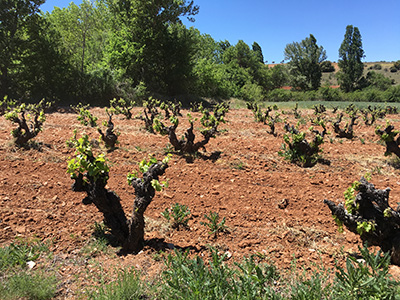Milsetentayseis
Pol. Industrial Allende Duero. Calle Asturias, 16. Nave 18. 09400 Aranda de Duero (Burgos)
www.milsetentayseis.com
A second, much smaller Pago de Carraovejas venture in Ribera del Duero, Milsetentayseis sources grapes from Fuentenebro (Burgos), home of some of the highest vineyards in the appellation. The project has been named after its highest plot, located at 1,076 metres above sea level with spectacular views over the region.
Since 2008, Carraovejas has actively searched for fresher areas to offset the effects of climate change. As their vineyards in Peñafiel (Valladolid) lie on a south-facing slope, the new vineyards have been planted high up on the moorland and in Espantalobos, the opposite, north-facing slope.
Having bought grapes from purveyors in Fuentenebro since 2006, the Ruiz family was well aware of the personality of the area, so it was just a matter of time that they started exploring its potential and decided to bottle the results. Aside from the elevation, another distinctive feature is the deep red, clay-ferrous soils, rich in mica, quartz and feldspar -these minerals were all extracted until not so long ago as it is evident by the remains of open cast mines. The land is irregular, with hills, canyons, some steep slopes and ravines.
Grapes are sourced from traditional vineyards and from others planted in recent times. Milsetentayseis owns 10 out of the 30 hectares of old vines in the village plus 12 hectares aged 12 to 30 years. The diversity of grape varieties in the old vineyards is striking. Apart from Tempranillo, at least 20 different varieties have been identified including Bobal, Graciano, Monastrell, Viura, Mazuelo, Xarel.lo, Cayetana Blanca, Jarrosuelto, Hebén and Moscatel de Grano Menudo, among others. All these biotypes will be preserved so that they can be used in the future.
A winery may be built in the near future in Fuentenebro, but in the meantime the wines are made in separate facilities in Aranda de Duero. Plots are fermented separately in a wide array of vessels (oak, concrete or clay) and the aim is to find the best match for each parcel. New barrels were used for the first vintage (2018), but since then seasoned oak features in 70% of the barrels.
Two wines have been released so far. Milsetentayseis La Peña (less than 1,200 bottles, €50) is an original rosé named after the vineyard it comes from. Tempranillo is residual here -most of the vines are Bobal and up to 50% are white varieties. Once the Bobal grapes are directly pressed, the wine is fermented and aged for six months in 600-litre casks. This is really original for Ribera del Duero: fresh, fine, well-defined, with herbal aromas, vibrant acidity and a pleasant chalky note on the finish.
The red Milsetentayseis (45,000 bottles, €54) blends different plots and tries to capture the character of Fuentenebro. The goal now is to increase the number of old vines in the blend. 2018 is the first release but from the 2019 vintage the blend will include about 5% of white Albillo.
Milsetentayseis is part of Alma Carraovejas, the wine business of the Ruiz family. This includes Pago de Carraovejas (Ribera del Duero), Ossian Vides y Vinos (Segovia), Viña Meín - Emilio Rojo (Ribeiro), Arrui (the new project in Rioja set to be released soon), the restaurant Ambivium located in Pago de Carraovejas and a small wine importing company called SV Wines.
Most popular
NEWSLETTER
Join our community of Spanish wine lovers


